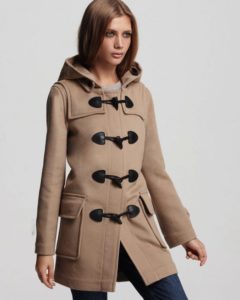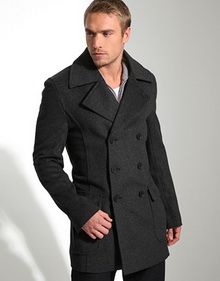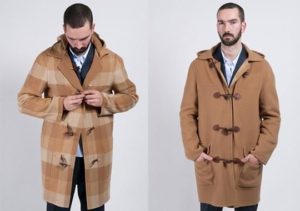It is impossible to imagine a modern person's wardrobe without at least one coat. The coat is convenient, comfortable, fashionable. It can become a bright accent in your image. A well-chosen coat will hide imperfections and highlight the beauty of your figure.
 Don't take your purchase lightly. Think through everything down to the smallest detail. It is necessary to take into account your body type, what you will wear the product with, and what style of clothing you adhere to. If you want your choice to always be relevant, stick to the classics.
Don't take your purchase lightly. Think through everything down to the smallest detail. It is necessary to take into account your body type, what you will wear the product with, and what style of clothing you adhere to. If you want your choice to always be relevant, stick to the classics.
There are many models that differ in style, color, and fabric structure. The coat can be combined with any type of clothing, for example: with a formal business suit, sportswear and casual style clothing.
You can choose a coat for the warm season - spring or early autumn - from cashmere, jersey, velvet, etc., or you can choose an option made from materials for the cold season: late autumn or winter - such as wool, tweed, drape, etc.
Types of women's coats
It’s hard to believe now that wearing a coat used to be the privilege of only men. For the first time, the female version was introduced into fashion by the favorite of King Louis XV of France, the Marquise de Pompadour. She added femininity and elegance to the “coat” imported from Spain (from the Spanish word for a spacious cloak with a hood), reshaping it to suit herself.
Pea coat
 Short double-breasted coat with a straight cut. Fabric - wool (maybe with the addition of synthetics). Once upon a time, the peacoat was part of the Marine uniform and served as protection from bad weather, however, over time, this type of clothing has undergone some changes.
Short double-breasted coat with a straight cut. Fabric - wool (maybe with the addition of synthetics). Once upon a time, the peacoat was part of the Marine uniform and served as protection from bad weather, however, over time, this type of clothing has undergone some changes.
However, the turn-down collar, which can be fastened on one side or the other (depending on the wind direction), and two rows of buttons (metal or wooden) remained unchanged. Patch pockets are sometimes replaced with welt pockets (straight or diagonal).
The color can be dark blue, dark green, black, white.
REFERENCE: The peacoat suits any body type. The V-neck and collar draw attention away from broad shoulders.
Duffle coat
 Short coat. Loose fit. Recognizable thanks to the hinged leather loops and elongated fang-shaped buttons. Has a hood and patch pockets. As with the previous model, the prototype was the uniform of the navy.
Short coat. Loose fit. Recognizable thanks to the hinged leather loops and elongated fang-shaped buttons. Has a hood and patch pockets. As with the previous model, the prototype was the uniform of the navy.
They were made from brushed fabric produced in the city of Duffel, hence the name. Colors are burgundy, dark green, sand, dark blue.
The duffle coat suits women with both slender and curvy figures. In the first case, it will emphasize the line of the silhouette, in the second, it will hide figure flaws.
IMPORTANT! Monitor the length of the shoulders to avoid skewing and select the correct size.
Chesterfield
 Long, semi-fitting cut English classic coat. Named after the sixth Earl of Chesterfield, who ordered something like a frock coat from a tailor at the beginning of the 19th century.
Long, semi-fitting cut English classic coat. Named after the sixth Earl of Chesterfield, who ordered something like a frock coat from a tailor at the beginning of the 19th century.
Coat with one or two sides. May have a hidden clasp, short lapels; It comes with flap pockets, often made of fabric with a herringbone pattern, sometimes with a corduroy or velvet collar.
REFERENCE: The strict cut is suitable for office wear and business casual. Can be worn without heels.
Cocoon
 A coat shaped like a cocoon. The main feature is the widening at the waist and tapering hem. Also called oversized. It has a softened silhouette and dropped shoulders. Rarely decorated with anything, loves minimalism.
A coat shaped like a cocoon. The main feature is the widening at the waist and tapering hem. Also called oversized. It has a softened silhouette and dropped shoulders. Rarely decorated with anything, loves minimalism.
There are models without a collar with a rounded neckline, also with short sleeves. Colors blue, beige, gray, pink, black, green. You can choose a style for both thin and curvy figures. It hides wide and excessively narrow hips well. Any model will suit tall and slender people.
ATTENTION! For women of short stature, it is recommended to choose a model that reaches the knees. It will look good with heels.
Cape
 An original coat in the form of a sleeveless cape, somewhat similar to a poncho. It is cut taking into account the trapezoidal body type. The clasp is usually located near the neck. The main advantages are freedom of movement and convenience. Made from dense fabric with pile or wool.
An original coat in the form of a sleeveless cape, somewhat similar to a poncho. It is cut taking into account the trapezoidal body type. The clasp is usually located near the neck. The main advantages are freedom of movement and convenience. Made from dense fabric with pile or wool.
The length of the product may vary. Suitable for women with any body type. Flowing vertical lines perfectly hide imperfections.
IMPORTANT! Those with curvy figures should carefully choose the length. It is better to opt for an elongated cape without a belt.
Redington
 Double-breasted coat in a classic style.Fitted silhouette with slight flaring at the bottom. Reminds me of an elongated jacket. It first appeared in England in the mid-18th century and was used for riding.
Double-breasted coat in a classic style.Fitted silhouette with slight flaring at the bottom. Reminds me of an elongated jacket. It first appeared in England in the mid-18th century and was used for riding.
It has wide lapels, flap pockets, velvet trim and an English collar. Emphasizes the fragility and femininity of the image, despite its laconicism and restraint.
IMPORTANT! Make sure that the skirt matches the edge. If the coat has a straight cut, then the skirt should be straight. It is not allowed to wear multi-layered clothing underneath.
Trench coat
 Double-breasted or breastless coat of various lengths. Straight cut. Turn-down collar, shoulder straps, vent, belt, tabs on the sleeves, yoke on the back.
Double-breasted or breastless coat of various lengths. Straight cut. Turn-down collar, shoulder straps, vent, belt, tabs on the sleeves, yoke on the back.
They are sewn from waterproof fabric, since its main task is protection from rain. For cooler seasons it has a warm lining. May be with fur trim.
REFERENCE: Suitable for women of any height and those with curvy figures.
Overcoat
 Coat with two sides of an adjacent or straight silhouette. With vent and pleat on the back. Has a strap, shoulder straps and metal buttons. Military style, looks like a military overcoat. Material: thick cloth.
Coat with two sides of an adjacent or straight silhouette. With vent and pleat on the back. Has a strap, shoulder straps and metal buttons. Military style, looks like a military overcoat. Material: thick cloth.
Poncho
 The ideal warm cape for any time of year. It can be with or without sleeves, with a belt and a hood. It was originally an Indian traditional clothing and was made from a single piece of fabric with a slit for the head.
The ideal warm cape for any time of year. It can be with or without sleeves, with a belt and a hood. It was originally an Indian traditional clothing and was made from a single piece of fabric with a slit for the head.
ATTENTION! Universal for all women, regardless of body shape.
Types of men's coats
There are different types of men's coats. The models are distinguished by functionality and practicality. A men's coat transforms the appearance, giving the image sophistication and a sense of style. The most elegant coat has always been and will always be the classic coat; it suits men of any age.
Important! The length of the coat is selected based on height. When choosing, consider your clothing style.
Crombie
 Short single-breasted coat in the English style with a turn-down collar and a hidden fastening. Named after John Crombie, who began producing this style in 1941. Laconic, characterized by a minimalist cut. Fabric: cashmere or wool. It can be an excellent addition to both business and casual style.
Short single-breasted coat in the English style with a turn-down collar and a hidden fastening. Named after John Crombie, who began producing this style in 1941. Laconic, characterized by a minimalist cut. Fabric: cashmere or wool. It can be an excellent addition to both business and casual style.
Important! The coat tails should cover the jacket.
Balmakaan
 Short single-breasted coat. Loose fit. With turn-down collar and raglan sleeves. The model originated in Scotland and was developed for hunting. Sewn from thick wool. Also used for manufacturing are tweed, crepe, and corduroy.
Short single-breasted coat. Loose fit. With turn-down collar and raglan sleeves. The model originated in Scotland and was developed for hunting. Sewn from thick wool. Also used for manufacturing are tweed, crepe, and corduroy.
Pardesu
 Cropped double-breasted coat. The name comes from the French “coat”. Popular with car enthusiasts.
Cropped double-breasted coat. The name comes from the French “coat”. Popular with car enthusiasts.
Pea coat
 Double-breasted short coat with large lapels and large buttons. Maybe with fur. Excellent protection from frosty winds. Soft woolen fabrics are used for production. Suitable for informal and classic style.
Double-breasted short coat with large lapels and large buttons. Maybe with fur. Excellent protection from frosty winds. Soft woolen fabrics are used for production. Suitable for informal and classic style.
Raglan
 A type of short coat with a turn-down collar. The idea of creation belongs to Lord Raglan. Thanks to the special sleeve, the shape of the shoulders is softly outlined. A notable feature is that there is no standard armhole.
A type of short coat with a turn-down collar. The idea of creation belongs to Lord Raglan. Thanks to the special sleeve, the shape of the shoulders is softly outlined. A notable feature is that there is no standard armhole.
Redington
 A coat of a tight-fitting silhouette, characterized by the absence of trim and unnecessary details. With a small English collar, vertical raised seams, stripes and logos on the chest, metal buttons on the sleeves. Intended for horse riding. For production, wool with the addition of cotton fibers is used.
A coat of a tight-fitting silhouette, characterized by the absence of trim and unnecessary details. With a small English collar, vertical raised seams, stripes and logos on the chest, metal buttons on the sleeves. Intended for horse riding. For production, wool with the addition of cotton fibers is used.
REFERENCE: Emphasizes the advantages of an athletic physique. Can be combined with clothes of different styles.
Duffle coat
 Coat of military origin. It appeared in the 18th century and initially served as a uniform jacket in the navy. Camel wool was used for production. Differences: hood, buttons shaped like a walrus tusk, checkered lining, flap pockets. Suitable for men who prefer an informal style.
Coat of military origin. It appeared in the 18th century and initially served as a uniform jacket in the navy. Camel wool was used for production. Differences: hood, buttons shaped like a walrus tusk, checkered lining, flap pockets. Suitable for men who prefer an informal style.
Trench coat
 Double-breasted oversized coat with epaulettes, strapped cuffs, vent and six buttons. A type of mac. Translated from English as “trench coat”. Made from wool, cotton, leather. It was popular during the First World War. Gabardine is based on a material with water-repellent properties. Color blue, black, khaki. Mandatory elements: yoke, turn-down collar, slit at the bottom, plaid fabric lining.
Double-breasted oversized coat with epaulettes, strapped cuffs, vent and six buttons. A type of mac. Translated from English as “trench coat”. Made from wool, cotton, leather. It was popular during the First World War. Gabardine is based on a material with water-repellent properties. Color blue, black, khaki. Mandatory elements: yoke, turn-down collar, slit at the bottom, plaid fabric lining.
Overcoat
 Double-breasted coat with a decorative tab on the back, cuffs on the sleeves, two rows of metallic buttons and a wide closed collar with lapels. Once the uniform of the military ground forces. Protected from snow, frost and wind. Previously, the material for production was thick cloth, now tweed and leather are used for creation. Suitable for respectable men.
Double-breasted coat with a decorative tab on the back, cuffs on the sleeves, two rows of metallic buttons and a wide closed collar with lapels. Once the uniform of the military ground forces. Protected from snow, frost and wind. Previously, the material for production was thick cloth, now tweed and leather are used for creation. Suitable for respectable men.
REFERENCE: There are no age restrictions.
Chesterfield
 Single-breasted or double-breasted coat, mid-knee length, with a semi-fitted and straight cut that beautifully outlines the figure. Straight chest pockets, short lapels. Gray or dark gray. Often with a velvet collar. It came into fashion in the 19th century.
Single-breasted or double-breasted coat, mid-knee length, with a semi-fitted and straight cut that beautifully outlines the figure. Straight chest pockets, short lapels. Gray or dark gray. Often with a velvet collar. It came into fashion in the 19th century.
ATTENTION! Double-breasted styles can create a massive silhouette. Not recommended for those with larger sizes. The neckline of the collar should not be lower than the neckline of the jacket.
Polo
 Short classic American coat. Relaxed fit, English collar, patch pockets and peak lapels.In the last century, it was made from sheep and camel wool. Worn for playing polo. Preferable for lovers of informal style. Material: soft cashmere. Light fabrics are used for tailoring.
Short classic American coat. Relaxed fit, English collar, patch pockets and peak lapels.In the last century, it was made from sheep and camel wool. Worn for playing polo. Preferable for lovers of informal style. Material: soft cashmere. Light fabrics are used for tailoring.
REFERENCE: It will look good and add solidity to an oversized style.
Covercott
 Single breasted short coat. Velvet trim on collar. Internal pockets. The name comes from English. "outerwear". Created for riding and hunting. Durable cloth was used in production. On the cuffs and hem, the seams were stitched up to 6 times. The main objectives are freedom of movement and comfort. Now the materials are soft cashmere and tweed.
Single breasted short coat. Velvet trim on collar. Internal pockets. The name comes from English. "outerwear". Created for riding and hunting. Durable cloth was used in production. On the cuffs and hem, the seams were stitched up to 6 times. The main objectives are freedom of movement and comfort. Now the materials are soft cashmere and tweed.
REFERENCE: Emphasizes the fit of the figure. A timeless model.


 0
0





